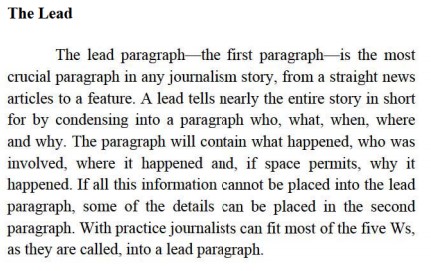
Introduction to Lead
Lead/Introduction (intro):
Definition: “In writing especially in journalism a led/intro is the opening paragraph of an article, essay, news or other written work that summaries the main ideas.”
Importance of lead:
The most important structural element of a story is a the lead. A lead must balance the ideal of maximum information conveyed with the constant of the unread ability of a long sentence. This makes writing a lead an optimization problem, in which the goal is to articulate the most encompassing and interesting statement that a writer can make in one sentence, given the material with which he/she has to work. Journalistic leads emphasize grabbing the attention of the reader. Leads in writing summarize the outline of the argument and conclusion that follows in the main body of writing.
Characteristics:
There are some important features of lead:
- Contain the essence of story: A lead should discuss what is the story about, thematically and why should we care? Think of the lead as part of headline.
- Communicate the key Information: Journalistic tradition would classify this data under the five W’s and one H: Who, What, Where, Why and How this system is useful to the writing of any story but a lead that contains all these points will often be overwrought. So only a few of those elements used. “What” is the most important factor and it is mostly discussed in a lead.
- Give Brief Summary: A snappy summary or a teaser is more likely to draw the reader attention. This approach highlight the priorities of the story and makes for better writing
- Capture the Imagination: A lead should raise questions, not just provide information. Otherwise we might be content with the factoid and stop reading. The why of those five W’s is always more complex than can be spelled out in a paragraph. If your lead open a window onto the complexities, we’ll fell challenged instead of patronized.
- Set Mood and Tone: leads can be intimate or cold, tragic or hilarious, hard hitting or celebratory. One of these choices will be right for your story, and a mismatch might be deadly.
- Point the way towards an Interpretation: Without insulting the reader’s intelligence whatever you put first in the story will determine how we read the rest of it.
- Be Appropriate to the Audience: A lead might contain a different idea in publication is geared primarily towards specific audience or general audience.
- Be As Concise as Possible: Don’t stall the reader with peripheral elements. Instead, make the lead on active dynamic agent.
- Use Short and Simple Sentences: Mainstream journalism prescribes a maximum 25 to 30 words for a lead. You can loosen it up a bit, but make sure you lead maintains its momentum.
- Told about Source: For an effective lead it sights the source of the news. i.e. Docaity happen in Farooq colony told by police. Police is source.



